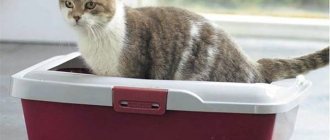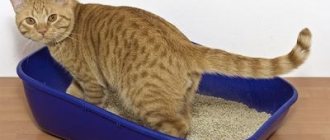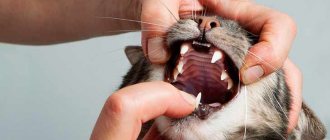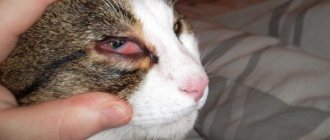Causes of blood in the stool Diagnosis Treatment Blood in the stool in a cat is not a disease, but a symptom in which bright red drops of blood or blood clots are visible in the stool. In this case, the feces may be of normal consistency and the animal itself behaves normally. However, if such stool is observed in a cat regularly, research should be carried out to determine the cause of this problem.
Scarlet blood in the stool usually indicates bleeding in the lower intestines (colon or rectum) and is a symptom of a number of diseases. If the bleeding occurs in other parts of the intestine, for example, in the small intestine of a cat, the blood in the stool will not be red in color and can only be determined by testing for occult blood in the stool (a cat with such bleeding may have black stool).
How to recognize blood in a cat's stool
Bloody stool in a cat indicates serious illness or injury to the gastrointestinal tract. Interacting with digestive media, it decomposes and takes on an unusual appearance. Because of this, it is difficult for the owner, unless he is a veterinarian or doctor, to determine that the cat is suffering from bleeding. A specialist can judge the location of the damage based on the appearance of the stool.
Appearance of bloody stool:
- hard stool with red streaks;
- an ordinary chair with bright red splashes;
- liquid “mush” of mucus, feces and blood, frequent bowel movements;
- black loose stools;
- hidden blood.
Hard stool with red streaks
A relatively harmless option is blood streaks in hard stool. They are clearly visible, and the owner will definitely not ignore such a sign. Sometimes veins appear only at the end of a bowel movement or when particularly dense and large excrement is released. The cause of the phenomenon is that hard feces damage the mucous membrane of the rectum or anus. This bleeding does not last long and usually stops on its own. Dangerous signs are the appearance of bloody streaks more than once, increased frequency (2-3 times a day) or decreased frequency (less than once a day) of stool, refusal to eat, restlessness of the animal, constant licking under the tail.
Red feces
If your cat's stool is normal or soft, and contains patches of various shades of red (from bright scarlet to dark), this is more dangerous. Bleeding occurs in the colon or lower small intestine. This condition is accompanied by other symptoms - refusal of food, anxiety, avoidance of owners, and possible vomiting. When you try to pick up the cat, and especially palpate the belly, he will scratch and bite. In this situation, you need to contact a veterinarian as quickly as possible; even a single appearance of blood in the stool indicates a serious injury and risk of infection.
Black feces
Non-obvious forms of bloody stool are black stool (melena) or occult blood. Both types are characteristic of bleeding in the upper parts of the small intestine. Black feces are a sign of severe damage. The color saturation is different - dark red, dark brown, gray-brown, black. Blood acquires this color as it passes through the digestive tract. The stool is soft or liquid, usually rapid. May be accompanied by vomiting; the animal almost always refuses food, but may drink a lot.
Dark stools may be due to the cat's dietary habits (for example, she was fed fresh raw meat) or iron supplements, and this can be misleading for owners.
hidden blood
The most difficult thing to recognize is occult blood. The stool has an almost normal appearance, but occurs somewhat more often than normal and is soft. Changes in the animal's behavior and frequent vomiting should alert owners.
To identify hidden or discolored blood in a cat’s stool, a peroxide reaction is used. A few drops of the solution are applied to the animal’s excrement.
Result options:
- There is no reaction - there is no blood. The color of the stool or the animal's behavior has changed for other reasons.
- Poor foam formation. It is normal if your cat is on a natural diet, has recently eaten raw meat, or has taken medications that can change the color of the stool. If the cat is on dry food and has not taken any medications, there may be a small amount of blood. Need veterinary advice.
- A strong reaction with foam - there is definitely blood in the stool, immediately contact a veterinarian.
What about mucus in the stool?
Slippery. Slimy. Nasty. These are all words veterinarians hear from cat owners describing excessive mucus in their cats' stool. Mucus is a normal secretion of the intestinal tract to help lubricate and moisten the intestines and facilitate fecal passage. It is not uncommon to observe some greasy or slippery coatings on your cat's feces. It is abnormal to see a lot of mucous, often clear to pale yellow-green fluid, accompanying your cat's bowel movements. Fecal mucus is an example of “the more the merrier.”
Blood in cat stool: causes
The most common reasons why a cat poops blood:
- improper feeding;
- constipation;
- poisoning;
- worms;
- foreign body in the intestine;
- inflammatory diseases (colitis, enteritis);
- tumors (benign and malignant).
Each of these reasons is serious enough to require action to eliminate it. If this is not done, the pet may die from an underlying disease, dehydration, blood loss, or sepsis (infection from the feces can enter the blood or abdominal cavity if the intestinal wall is damaged).
Nutrition
The most common cause of blood in a cat's stool is improper feeding. An abundance of dry food with a lack of water leads to the fact that a poorly moistened bolus of food injures the intestinal walls. Feces are dense and rough, they can cause constipation and also injure the intestines.
Chicken and fish bones in your pet’s diet pose a separate danger. The cat does not chew them, but gnaws them into small pieces with sharp edges, which can injure the walls of the gastrointestinal tract along its entire length. As long as there are no serious injuries, the cat does not need to be treated, but its diet should be changed. Fluffy needs unlimited access to water (not milk or other liquids), and it is worth adding wet food, boneless meat or dairy products (if the cat tolerates them). Be sure to prevent your cat from accessing the trash can.
Poisoning
Poisoning often occurs in cats that walk outside or have access to household chemicals in the house. Food poisoning in cats is relatively easy; the main thing is to ensure that the animal has constant access to water and does not develop dehydration. But if a cat goes to the toilet with blood after walking down the street, this is a dangerous sign. Cats are often poisoned by poisons for rats and mice, suffer from the actions of dog hunters, and in this case an antidote is needed. If the owner does not know what substance the animal was poisoned with, the chances of saving the animal are reduced. Self-medication in this case is dangerous, you need to contact a veterinary clinic.
Helminthiasis
With parasitosis, the cat often produces bloody feces. The mechanism of damage to the intestinal wall depends on the type of parasite. Worms damage the wall mechanically with their fixation organs or skin. Protozoa and some worms secrete toxins that reduce intestinal motility and dilate blood vessels, leading to bleeding. It is impossible to determine helminthiasis by the nature of the stool; diagnosis is needed in a veterinary clinic.
Foreign object
A foreign body enters the intestines if the cat swallows it. Usually these are large clumps of wool, human hair, threads, pieces of polyethylene. If they do not come out with vomiting, they can get into the intestines and injure its wall with sharp edges or a hard surface. If a cat has swallowed a long and thin object (hair, thread, New Year's rain), you cannot pull it out of the mouth or anus - this is the most common cause of ruptures of the esophagus and rectum. If a foreign body is suspected, the animal should be taken to a veterinarian.
Diagnostics
If the owner notices blood and mucus in the cat’s stool, you need to contact a veterinarian for a diagnosis as soon as possible. The only situation when this is not necessary is if the most likely cause is improper feeding, and other than toilet problems there are no changes in behavior. Then you can switch the animal to wet or natural food for 2-3 days and give plenty of water. In a healthy cat, stool will return to normal. In all other situations, self-medication and delaying treatment are dangerous for the cat.
The veterinarian will ask about the nature of the stool, the conditions in which the pet is kept, and changes in behavior. This is important to suggest what could be the cause of the bleeding. The doctor will examine the cat's anus, genitals, and tail to look for injuries, if any.
Then you need to take tests:
- Fecal analysis (in cats, one procedure combines general scatology, worm eggs, occult blood).
- A blood test will show signs of inflammation, parasitosis, poisoning and anemia.
- Ultrasound of the abdominal cavity - reveals areas of bleeding, inflammation and ulcerations on the mucous membrane, parasitic worms.
- Rectal smear - to identify pathologies near the anus.
- Colonoscopy allows you to “examine” the intestinal wall from the inside.
- X-ray of the abdominal cavity with contrast or CT scan with contrast reveals all defects in the intestinal walls.
The number of tests may vary depending on the stage at which the causes of blood in the stool are identified. Sometimes it is enough to identify the eggs of worms; in difficult cases, it is necessary to carry out diagnostic procedures until the truth is established.
What to pay attention to
If blood is detected in your pet’s stool, do not immediately panic. Droplets of blood in the excrement may appear due to trauma to the anus during defecation. This is possible if the stool was very hard. The symptom is unpleasant and may indicate a problem with the gastrointestinal tract. But in this case, immediate consultation with a doctor is not required.
You should take your cat to the vet immediately if:
- There is a lot of blood in the stool, red puddles form on the filler.
- Blood in the stool is constantly observed.
- The animal has severe constipation, or vice versa, diarrhea.
- Body temperature is greatly increased.
- There is a decline in activity and apathy.
- Severe vomiting.
- The stool also contains particles of undigested food or mucus.
It is worth noting that red blood in the stool appears when there are problems in the lower intestine. If the functioning of the upper section is disrupted, the feces will be black. So if you find black feces, you should also pay close attention to the health of your pet. Black stool also indicates bleeding in the intestines. If there are no other symptoms of the animal’s disease, then the pet should be observed for some time.
Please note the following:
- Does blood appear in stool again?
- How does the cat behave during defecation: perhaps meowing, experiencing discomfort.
- Is the anus inflamed? Is the cat licking it?
- Has the food changed recently?
- Is drinking water always freely available?
- When was preventive deworming carried out?
- When was the last time a cat cleaned its stomach of fur?
- Could the animal have eaten something unsuitable for food, for example, a poisonous plant?
Treatment depending on the cause
Treatment of intestinal pathologies is prescribed by a veterinarian. The owner must strictly follow his recommendations. The treatment regimen depends on what exactly caused the bleeding.
Poisoning
Poisoning is treated in 4 stages:
- Gastric lavage to remove poison that has not yet been absorbed. Vomiting is contraindicated as it may worsen the animal's condition.
- Administration of electrolytes and forced diuresis. The cat is given intravenous solutions of electrolytes and diuretics to remove the poison from the blood. Required for severe and moderate poisoning.
- Antidote. Neutralizes harmful substances and their metabolites. It is administered if it is known what the cat was poisoned with. For food poisoning, an antidote is not required.
- Symptomatic help.
After the course of treatment, it is important for the cat to take especially careful care in order to completely eliminate all the consequences of poisoning. It is necessary to exclude walks on the street and uncontrolled selection of food.
Parasitic and infectious diseases
For their treatment, drugs of 3 groups are used:
- Etiotropic – affect the causative agents of the disease (antibiotics, anthelmintic drugs).
- Pathogenetic – stop pathological processes (anti-inflammatory drugs, hemostatic agents, electrolytes).
- Symptomatic – against pain, fever and other symptoms.
Features of specialized treatment
Treatment of diseases that are accompanied by bloody diarrhea should be carried out by a qualified specialist. Treatment of the disease must be implemented as quickly as possible, otherwise the owner risks losing his pet.
Specialized treatment of bloody diarrhea in cats has several goals:
- determining the cause of a pathological symptom using modern laboratory and instrumental diagnostic methods;
- prescription of etiotropic therapy;
- symptomatic treatment of complications;
- competent rehabilitation of the animal.
The decisive factor when choosing treatment tactics for loose, bloody stools is the cause of the development of the underlying pathology that led to such consequences. If the process was provoked by pathogenic microorganisms, then the doctor decides to prescribe antibacterial therapy lasting from 14 to 21 days with a control stool test. Helminthic infestations are treated with anthelmintic drugs, and chronic colitis is treated with normalization of feeding and restoratives. Qualified treatment is effective in almost 90% of cases, and its results depend on the timely diagnosis of the disease, the correctness of therapeutic tactics and the individual characteristics of the sick cat’s body.











